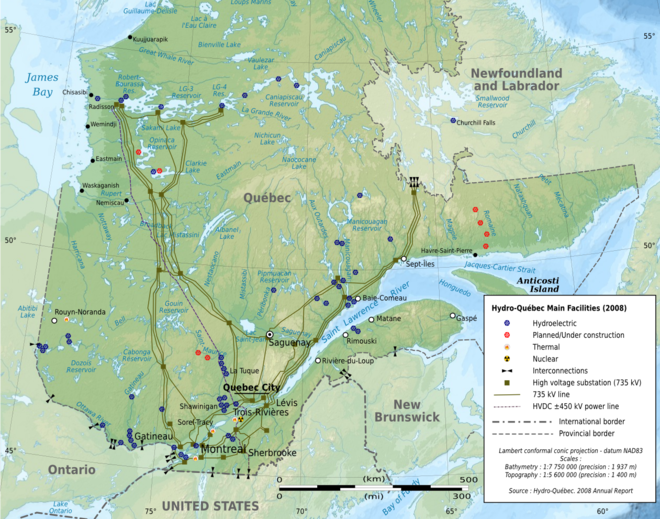A 2008 map of Hydro Quebec facilities
From ecoRI News (ecori.org)
An MIT study claims that hydropower from Quebec can provide stored energy and solve the intermittency issues afflicting wind and solar power. Researchers at the MIT Center for Energy and Environmental Policy Research illustrate how “two-way” electricity trading between New England, New York and Quebec can reduce energy-system costs, decrease natural-gas use, and limit the need for emerging technologies such as carbon capture and sequestration.
To get there, 4 gigawatts of new transmission lines must built between New England and Quebec so that existing hydropower reservoirs can send power on demand.
Meanwhile, attorneys general from Rhode Island and Massachusetts signed on to a letter in support of a 2018 rule by the Federal Energy Regulatory Commission that requires utilities to include energy storage in wholesale electricity markets. The rule is being appealed by utilities through groups such as the American Public Power Association over anticipated cost increases. The states say the rule would create billions in economic and environmental benefits.
Mayflower Wind record price
The 804-megawatt Mayflower Wind project being developed by Royal Dutch Shell and EDP Renováveis in the wind-energy zone south of Martha’s Vineyard and Nantucket was recently awarded a power-purchase contract of 5.8 cents per kilowatt-hour from the Massachusetts utilities that will be buying the electricity. The price agreement offered by Eversource, National Grid, and Unitil needs to be approved by the Massachusetts Department of Pubic Utilities.
The record low price is less than the previous low of 6.5 cents for the 800-megawatt Vineyard Wind project.
More than $70 billion of potential investments in offshore wind facilities are proposed between North Carolina and Maine, but all await the outcome of an overdue federal environmental review on the Vineyard Wind project by the federal Bureau of Ocean Energy Management.
Public comment for offshore wind
The public has until March 16 to comment on a Coast Guard proposal for the layout and navigable shipping routes for the seven leased wind areas in federal waters. The Massachusetts and Rhode Island Port Access Route Study recommends spacing of 1 nautical mile between the turbines. Developers generally favor the layout, while the commercial fishing industry prefers 4-mile transit corridors and a design that limits radar interference.
Tim Faulkner is an ecoRI News journalist.











